Acromioclavicular (AC) Joint Injuries
What is an AC Joint Injury?
The AC joint is the area where the acromion (located at the top of the shoulder blade) and the clavicle are connected. The AC joint is a plane synovial joint, and the acromion and clavicle are connected via the acromioclavicular ligament. AC joint injuries involve disruption to the acromioclavicular ligament. AC joint injuries can also coincide with disruption to the coracoclavicular (CC) ligament which joins the clavicle and the coracoid process.
Types of AC Joint Injuries
There are six different types of AC joint injuries according to the Rockwood Classification system. These six injuries types are:
- Type 1: Sprain to the AC ligament with a non-disrupted CC ligament. The x-ray may appear normal or there will be slight widening of the AC joint. Physical examination will show no visible deformity, yet pain and swelling around the AC joint will be reported.
- Type 2: Tear of the AC ligament with a sprain to the CC ligament. The clavicle will be slightly elevated yet still within the superior border of the acromion. The join capsule will be ruptured.
- Type 3: Both the AC and CC ligaments are torn. The clavicle is no longer within the superior border of the acromion. The CC is displaced at a distance less than 25 mm (less than twice the normal joint distance). During physical examination the distal clavicle is unstable to horizontal and vertical stress.
- Type 4: Both the AC and CC ligaments are torn. The clavicle is posteriorly displaced into the trapezius.
- Type 5: Both the AC and CC ligaments are torn and the deltotrapezial fascia is ruptured. The CC distance is greater than 25 mm (more than twice the normal joint distance), and the clavicle is markedly displaced and may reside just under the skin. Radiographs show that the distal clavicle is elevated (>100% to 300%). Physical examination shows that the clavicle is palpable subcutaneously and is not reducible.
- Type 6: Both the AC and CC ligaments are torn. The clavicle is lodged behind the biceps and coracobrachialis tendons, located beneath the acromion and/or coracoid.
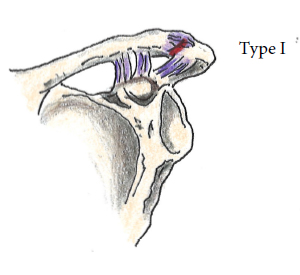
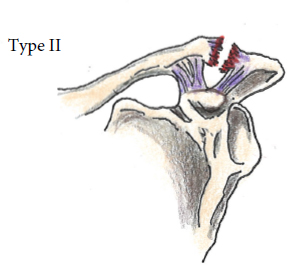
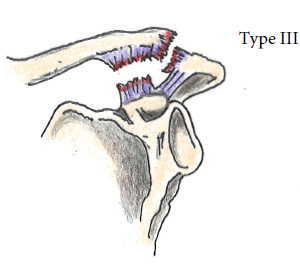
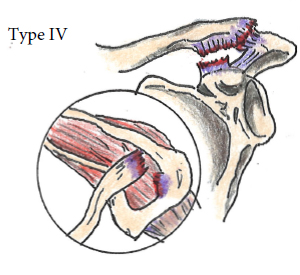
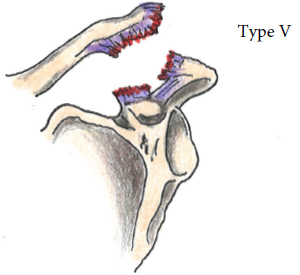
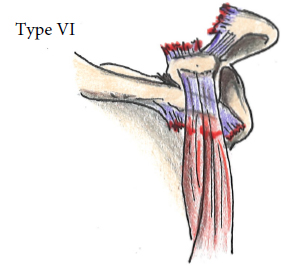
Causes of AC Joint Injuries
Injuries at the AC joint can be caused by overuse or trauma. Trauma to the AC joint can involve falling and landing on this portion of the shoulder or receiving a direct blow to the shoulder. Overuse can occur with activities that involve repetitive overhead lifting, such as weightlifting.
Symptoms of AC Joint Injuries
Symptoms of this type of injury can include:
- Pain in the AC joint region
- Limited motion due to pain and stiffness
- Swelling
- Tenderness
- Bruising
- Noticeable deformity of the collarbone
Diagnosis of AC Joint Injuries
In order to diagnosis an AC joint injury your physician will conduct a physical exam and will likely order an x-ray of the shoulder.
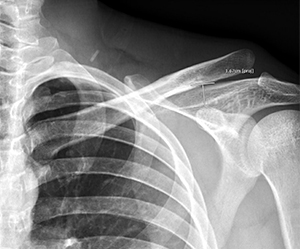
Above Image: X-ray before surgery for Case #1 showing a type five AC joint injury.
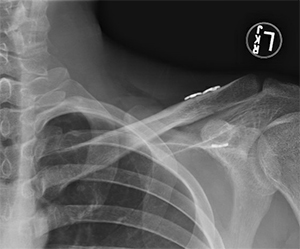
Above Image: X-ray after surgery for Case #1 showing the clavicle has been returned to its normal positioning.
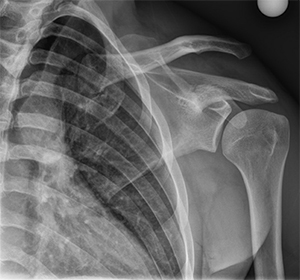
Above Image: X-ray before surgery for Case #2 showing a type five AC joint injury with extreme elevation of the clavicle from the AC joint region.
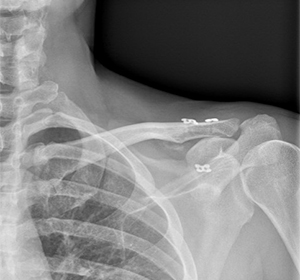
Above Image: X-ray after surgery for Case #2 showing the clavicle has been returned to its normal positioning.
Treatment Options
The plan of action for treating an AC joint injury depends on the severity of the injury. Type 1, 2, and 3 surgeries are typically treated without surgery, while Type 4, 5, and 6 are usually addressed via surgery.Treatment without surgery can include:
- Applying ice or cold packs to the injured site to reduce swelling and pain
- Immobilizing and resting the shoulder
- Taking anti-inflammatory medications
- Physical therapy and range of motion exercises
- Bone marrow-concentration injections
Surgical options:
- Reconstructing the ligaments to keep the clavicle at its normal position
- Using metal or sutures to hold the clavicle in place
- Minimally invasive “Finger-Scopic” Technique
- Developed by Dr. Josef Eichinger
- www.journals.lww.com/shoulderelbowsurgery/Fulltext/2018/06000/Acute_AC_Dislocation_Repair_in_the_Supine_Position.9.aspx







